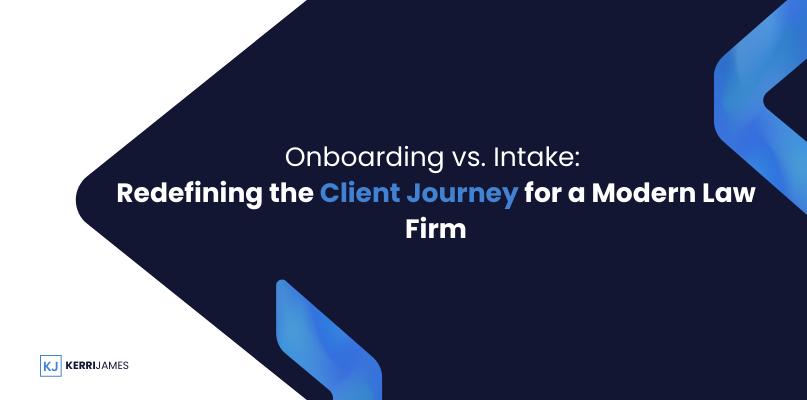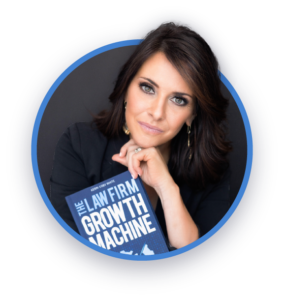In the competitive world of legal services, where client expectations are higher than ever, being a skilled legal practitioner isn’t enough. Clients now expect a comprehensive experience characterized by empathy, transparency, and seamless communication. Mastering the art of client acquisition is paramount, and it all begins with a clear understanding of two fundamental stages in the client journey: intake and onboarding.
While often used interchangeably, “intake” and “onboarding” represent distinct processes, each with its own set of goals, approaches, and psychological dynamics. These two phases serve as critical chapters in your client’s experience, shaping how they perceive your firm and determining the likelihood of a successful, long-term relationship.
Chapter one, “intake,” is the first point of contact — the stage where the client’s trust is earned, and the groundwork is laid for a strong attorney-client relationship. Intake is about building rapport, understanding the client’s concerns, and turning leads into paying clients through empathy and clear communication.
Chapter two, “onboarding,” represents the shift from relationship building to case preparation. This phase focuses on gathering essential details, setting clear expectations, and creating a structured plan to move forward with the client’s case.
Recognizing the inherent differences between these two stages is critical. Failing to distinguish between intake and onboarding can result in an inefficient process that overwhelms clients and creates missed opportunities. When done correctly, a two-part approach enhances both the client experience and operational efficiency.
Section 1: What is Intake? The Art of Converting Leads into Clients
Intake is the crucial first step in the client journey. It’s the initial interaction where a potential client reaches out for guidance, often in the midst of stress or emotional upheaval. How this conversation is handled can determine whether they choose to entrust you with their legal needs.
Empathy: The Heart of Effective Intake
Intake is not simply about gathering information; it’s about connecting with the client on an emotional level. Unlike buying a product, seeking legal help is rarely a transactional decision. Clients contact law firms when they are dealing with emotionally charged situations — personal injury, divorce, criminal charges, or business disputes. Your intake team must approach these situations with empathy, acknowledging the client’s emotions and offering reassurance.
Consider a client who has just been involved in a car accident. They are likely experiencing a range of emotions, from fear and frustration to physical pain. The ability of your intake team to acknowledge these emotions can make all the difference. If your team approaches the conversation with a calm, empathetic demeanor, the client will feel heard, supported, and more likely to trust your firm.
Mirroring and Validation: Building Connection Through Language
One effective strategy in intake is mirroring the client’s language and validating their emotions. Phrases such as “That sounds incredibly overwhelming” or “I can understand why you’re feeling stressed” help to build rapport by showing the client that you’re truly listening. These simple affirmations show that you care about their emotional state, not just their legal case, which fosters trust and encourages open communication.
Guiding the Conversation with Expertise: Balancing Empathy with Efficiency
While empathy is essential, efficiency is equally important during intake. Your team must gather enough information to assess the client’s legal needs and determine whether their case aligns with your firm’s expertise.
Key information to gather includes:
- What happened? Establish the basic facts: the event, location, date, and parties involved.
- What are the legal implications? Determine whether the potential client has a valid legal claim.
- Is this case a good fit for your firm? Assess factors like the severity of the case, potential liability, and whether the client’s expectations align with your services.
Your intake team must ask focused, targeted questions to uncover these details while maintaining a conversational, empathetic tone. This balance of empathy and expertise ensures that clients feel supported while you gather the necessary information to make an informed decision.
The Power of “We”: Fostering Collaboration From the Outset
Inclusive language is another powerful tool during intake. Using “we” instead of “you” helps to foster a sense of partnership. For instance, instead of saying, “You need to provide us with your insurance information,” you could say, “We’ll need to gather some documents together, such as your insurance details.” This subtle shift in language positions your firm as an ally rather than a detached service provider.
Securing the Commitment — A Moment of Trust, Not Pressure
The ultimate goal of intake is to convert a potential client into a paying client. However, this conversion should come from a place of trust rather than pressure. Once rapport has been established and the client feels comfortable with your firm, presenting a simplified engagement letter is the next step.
This document should be clear and concise, outlining the terms of the legal representation in plain language. Avoid overwhelming the client with legal jargon during this early stage. The more complex details can be addressed during the onboarding process, where you’ll have more time to explain the ins and outs of the case.
Section 2: Onboarding — Laying the Groundwork for a Successful Case
Once the client has agreed to proceed, the focus shifts from building a relationship to building a case. This transition marks the beginning of the onboarding process, where detailed information gathering, case preparation, and communication strategies are implemented.
The Onboarding Analogy: Building a Strong Foundation
Think of onboarding as laying the foundation for a house. Just as you wouldn’t begin construction without a solid foundation and clear plans, you can’t begin working on a legal case without first collecting the necessary documents and details. Effective onboarding ensures that you have all the essential elements in place before proceeding with the legal strategy.
Key Elements of a Successful Onboarding Process
- Comprehensive Information Gathering: Leaving No Stone Unturned
Onboarding is the time to dive deep into the details of the client’s case. This includes gathering all relevant documentation — police reports, medical records, contracts, financial statements, or any other evidence pertinent to the case. Thoroughness at this stage is crucial to avoid potential delays or complications later in the litigation process. Organize this information methodically, creating a system that allows for easy access and retrieval. Consider utilizing digital tools like cloud-based document management systems to streamline this process and ensure that all case-related information is secure and readily available. - Form Completion Made Easy: Utilizing Technology to Streamline the Process
Onboarding often involves filling out forms, signing documents, and sharing sensitive information. Leveraging technology to make this process easier is a must in today’s digital age. Utilizing e-signature tools, online forms, and secure client portals can simplify the process for both your team and the client, reducing the time and effort required to complete the onboarding process. - Setting the Stage for Communication: Establishing Clear Channels and Expectations
One of the most important aspects of onboarding is setting clear expectations around communication. Introduce the client to their designated point of contact within your firm, explain how often they can expect updates on their case, and outline the preferred methods of communication — whether that’s phone, email, or a secure online portal. Provide written guidelines that clearly outline communication protocols, ensuring that both parties are on the same page regarding response times, preferred communication methods, and escalation procedures. This proactive approach helps build trust, minimizes misunderstandings, and ensures that both the client and your team are on the same page. - Managing Expectations: Transparency and Realistic Timelines
Onboarding also provides the opportunity to manage client expectations regarding the legal process. Litigation can be unpredictable and often involves long timelines. Be upfront about potential challenges, how long the process may take, and what the client can expect at each stage. This transparency builds trust and helps to prevent frustration if there are delays or unexpected developments. Consider creating a visual timeline or flowchart that illustrates the key stages of the legal process and the estimated time frames involved. This visual aid can be a helpful tool for clients to understand the journey ahead and manage their expectations accordingly.
By the end of the onboarding process, both you and the client should feel confident and prepared for the legal journey ahead. You’ll have a strong foundation of trust, a clear understanding of the case, and a shared commitment to achieving the best possible outcome.
Section 3: The Power of Two — Why Separating Intake and Onboarding Matters
In a fast-paced legal environment, where time and resources are limited, separating intake from onboarding can have a profound impact on both client experience and operational efficiency. By keeping these two stages distinct, you ensure that each serves its purpose effectively, leading to better outcomes for both your clients and your firm.
Benefits for Your Clients: A Human-Centered Approach
- Reduced Overwhelm: Prioritizing Emotional Well-being
Legal issues are inherently stressful, and clients often feel overwhelmed when confronted with the administrative aspects of their case. By breaking the client journey into two distinct stages, intake can focus on emotional support and initial information gathering, while onboarding can address more complex logistical tasks. This approach allows clients to absorb information at a manageable pace, reducing the risk of emotional burnout. - Increased Transparency and Control: Empowering Clients Through Understanding
Clients are more likely to feel confident in their legal representation when they fully understand the process. Separating intake and onboarding gives you the time to explain legal procedures, timelines, and potential outcomes more thoroughly during onboarding. This increased transparency empowers clients to make informed decisions and fosters a sense of control over their case. - Enhanced Client Experience: Setting the Stage for Satisfaction and Loyalty
A well-organized, empathetic approach to intake and onboarding can significantly enhance the client experience. Clients who feel valued and supported are more likely to have positive feelings about your firm, which translates into increased satisfaction and, ultimately, referrals. By streamlining the intake and onboarding processes, you demonstrate that you respect your clients’ time and well-being, leading to stronger, longer-lasting relationships.
Benefits for Your Firm: Optimizing Operations and Enhancing Profitability
- Increased Efficiency and Focus: Specialization for Streamlined Operations
Separating intake and onboarding allows for task specialization within your team. Intake specialists can focus on converting leads and building rapport, while onboarding specialists concentrate on gathering detailed case information and managing logistical tasks. This division of labor increases efficiency and reduces the risk of errors, enabling your firm to operate more smoothly and effectively. - Improved Data Accuracy: Minimizing Errors and Maximizing Efficiency
When onboarding is treated as a separate, detailed process, the chances of errors or missed information are significantly reduced. Clients have more time to gather and provide accurate documentation, and your team can take the necessary time to ensure that all forms are completed correctly. This meticulous approach saves time in the long run by minimizing the need for follow-ups and corrections. - Enhanced Profitability: The Ripple Effect of Efficiency and Client Satisfaction
A more efficient intake and onboarding process translates directly into improved profitability. With a streamlined intake process, your firm can convert more leads into clients, while a well-structured onboarding process reduces errors and inefficiencies. Satisfied clients are more likely to refer others to your firm, further boosting your business. Over time, these small improvements compound into significant gains in both client satisfaction and profitability.
The Verdict: Embrace the Two-Part Conversion for a Win-Win Client Journey
In today’s legal landscape, where client expectations are rapidly evolving, embracing innovative, client-centered processes is essential for staying competitive. The two-part conversion process, with its clear distinction between intake and onboarding, exemplifies how a small shift in approach can yield significant benefits for both your clients and your firm.
By recognizing the unique roles of intake and onboarding, you create a more organized, empathetic, and efficient client journey. Intake focuses on building rapport, establishing trust, and converting leads, while onboarding ensures that you have the detailed information and clear expectations needed to build a strong case.
This two-part approach not only enhances the client experience but also improves your firm’s operational efficiency and profitability. Clients who feel valued and understood are more likely to remain loyal and refer others, while your team can work more effectively with clear processes in place.
In a world where client experience is paramount, this approach is a win-win — for your clients, your team, and your firm’s long-term success. By implementing this client-centric method, you empower your team to operate at its best, foster stronger attorney-client relationships, and pave the way for a more profitable and fulfilling legal practice.










